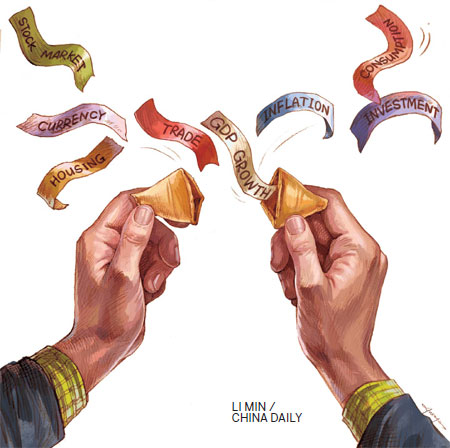What lies ahead
Updated: 2013-01-04 09:01
By Andrew Moody (China Daily)
|
||||||||

Performance of Western economies has bearing on China's growth, which in turn could have an impact on African and other developing countries
The world economy enters 2013 with significant risks that could blow any nascent signs of recovery off course - with most experts agreeing there is little chance the new year will be the one when we finally see what is now being called the Great Recession in the rear-view mirror.
China's GDP growth has slowed post-Lehman and was down for a seventh successive quarter at 7.4 percent between July and September with the prospects for this year uncertain.
This is because the world's second-largest economy still remains largely dependent on its vital export markets to the United States and Europe.
The euro deal reached in autumn looks to have staved off an immediate crisis but the German election later in the year could lead to policy paralysis before then.
The US has so far proved to be the most buoyant Western economy but with the "fiscal cliff" barely avoided, there remains the risk that recent spurts of growth might prove a false dawn.
Given the interconnectedness of the world, weak Western economies would impact on China and then also emerging markets in Africa, which is now highly dependent on its largest trade partner's demand for commodities.
How China's main stock market will fare in 2013 after another depressing 12 months will also be of interest to investors trying to buy into the China growth story.
The Shanghai Composite Index hit a 46-month low of under 2000 points in November, less than a third of its heady October 2007 high of 6124.
From pages 6 to 15, we also look in depth at some of the major issues facing China in 2013 from its ageing population (this year its workforce will fall in number for the first time in recent history) through the prospects for the housing market to the development of new sectors such as green energy.
We will also examine the outlook for trade, foreign direct investment into China and, in turn, the country's investment overseas, the prospects for the internationalization of the yuan, the emergence of a consumer society, research and development and also focus on China's stock exchanges.
Gary Rieschel, founder of Shanghai-based Qiming Venture Partners, a $1-billion (760 million euros) fund focused on early stage investments, says 2013 might be the year when growth in China is viewed in a different way.
"I think the China growth story is actually becoming less about the rate of change but the amount of aggregate dollars added to the economy," he says.
"As the economy becomes larger you would expect the rate of growth to slow but it is growing from a bigger base and therefore the volume of business opportunities is increasing."
Mark Williams, chief Asia economist for Capital Economics, the London-based economics research group, was one of the most bearish on the China economy in 2012.
He caused controversy earlier last year by suggesting second-quarter growth was more likely 7 percent, rather than the official 7.6 percent, using flat electricity production data as his benchmark.
Yet he now sees growth in 2013 as higher than in 2012 at 8 percent, although slowing to 7.5 percent in 2014.
"Our view is that the recovery we have seen in the past few months is real but that it is not going to last for too much longer without policy stimulus," he says.
"I think China's long term sustainable growth rate is now between 7.5 and 8 percent and we shouldn't expect it to grow more than that."

 Li Na on Time cover, makes influential 100 list
Li Na on Time cover, makes influential 100 list
 FBI releases photos of 2 Boston bombings suspects
FBI releases photos of 2 Boston bombings suspects
 World's wackiest hairstyles
World's wackiest hairstyles
 Sandstorms strike Northwest China
Sandstorms strike Northwest China
 Never-seen photos of Madonna on display
Never-seen photos of Madonna on display
 H7N9 outbreak linked to waterfowl migration
H7N9 outbreak linked to waterfowl migration
 Dozens feared dead in Texas plant blast
Dozens feared dead in Texas plant blast
 Venezuelan court rules out manual votes counting
Venezuelan court rules out manual votes counting
Most Viewed
Editor's Picks

|

|

|

|

|

|
Today's Top News
Boston bombing suspect reported cornered on boat
7.0-magnitude quake hits Sichuan
Cross-talk artist helps to spread the word
'Green' awareness levels drop in Beijing
Palace Museum spruces up
First couple on Time's list of most influential
H7N9 flu transmission studied
Trading channels 'need to broaden'
US Weekly

|

|








